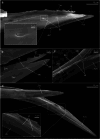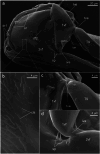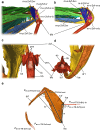Structure and function of the ovipositor of the encyrtid wasp Microterys flavus
- PMID: 40855312
- PMCID: PMC12376389
- DOI: 10.1186/s12983-025-00575-1
Structure and function of the ovipositor of the encyrtid wasp Microterys flavus
Abstract
Background: Oviposition is crucial for the reproductive success of parasitoid insects and, hence, ovipositor structure and oviposition behaviour have probably played a central role in their adaptive evolution. However, various mechanical and functional aspects of the musculoskeletal ovipositor system are still not fully understood, especially within the enormously diverse parasitoid wasps, e.g. the minute and understudied Encyrtidae (Chalcidoidea). Some encyrtid wasps are specialized in parasitising insect plant pests and thus play an important ecological and economic role. We have examined all inherent cuticular elements and muscles of the ovipositor of the encyrtid wasp Microterys flavus to improve our understanding of its mechanics and mode of function. We provide a detailed 3D model based on a synchrotron X-ray phase-contrast microtomography (SR-µCT) dataset and have analysed microstructures on the cuticular ovipositor elements by using scanning electron microscopy (SEM). We have also conducted an in vivo documentation of the oviposition process of female M. flavus wasps on their host, the scale insect Coccus hesperidum.
Results: Based on morphological analyses, we have identified all elements of the musculoskeletal ovipositor system in M. flavus, consisting of two pairs of valvifers, three pairs of valvulae, the female T9 (9th abdominal tergum), and a set of nine paired ovipositor muscles. Three of these muscles (1st valvifer-genital membrane muscle, ventral 2nd valvifer-venom gland reservoir muscle, T9-genital membrane muscle) have only recently been discovered in pteromalid wasps but have not yet been described for encyrtids. Our behavioural analysis of the motion patterns during the various phases of parasitization has elucidated the oviposition process, which consists of penetration of the host's body, assessment of the host's internal organs, envenomation, egg deposition, and potential host feeding.
Conclusions: Based on our studies of the structure of the ovipositor system of the encyrtid wasp M. flavus, we have developed a functional model of the underlying working mechanism of all ovipositor movements observed during the oviposition process, thereby improving our understanding of a possible key trait contributing to the evolutionary success of a highly diverse group of chalcidoid wasps.
Keywords: Chalcidoidea; Encyrtidae; Functional morphology; Hymenoptera; Ovipositor; Parasitoid; Terebra.
© 2025. The Author(s).
Conflict of interest statement
Declarations. Ethics approval and consent to participate: No approval of research ethics committees was required to accomplish the goals of this study because experimental work was conducted with an unregulated invertebrate species. Consent for publication: Not applicable. Competing interests: The authors declare that they have no competing or financial interests.
Figures










Similar articles
-
Terebra steering in chalcidoid wasps.Front Zool. 2023 Aug 8;20(1):26. doi: 10.1186/s12983-023-00503-1. Front Zool. 2023. PMID: 37553687 Free PMC article.
-
Loss of olfaction reduces caterpillar performance and increases susceptibility to a natural enemy.Elife. 2025 Aug 1;14:RP105585. doi: 10.7554/eLife.105585. Elife. 2025. PMID: 40747879 Free PMC article.
-
Prescription of Controlled Substances: Benefits and Risks.2025 Jul 6. In: StatPearls [Internet]. Treasure Island (FL): StatPearls Publishing; 2025 Jan–. 2025 Jul 6. In: StatPearls [Internet]. Treasure Island (FL): StatPearls Publishing; 2025 Jan–. PMID: 30726003 Free Books & Documents.
-
The Black Book of Psychotropic Dosing and Monitoring.Psychopharmacol Bull. 2024 Jul 8;54(3):8-59. Psychopharmacol Bull. 2024. PMID: 38993656 Free PMC article. Review.
-
Systemic pharmacological treatments for chronic plaque psoriasis: a network meta-analysis.Cochrane Database Syst Rev. 2017 Dec 22;12(12):CD011535. doi: 10.1002/14651858.CD011535.pub2. Cochrane Database Syst Rev. 2017. Update in: Cochrane Database Syst Rev. 2020 Jan 9;1:CD011535. doi: 10.1002/14651858.CD011535.pub3. PMID: 29271481 Free PMC article. Updated.
References
-
- Peters RS, Krogmann L, Mayer C, Donath A, Gunkel S, Meusemann K, et al. Evolutionary history of the Hymenoptera. Curr Biol. 2017;27:1013–8. 10.1016/j.cub.2017.01.027. - PubMed
-
- Vilhelmsen L, Miko I, Krogmann L. Beyond the wasp-waist: structural diversity and phylogenetic significance of the mesosoma in apocritan wasps (Insecta: Hymenoptera). Zool J Linn Soc. 2010;159:22–194. 10.1111/j.1096-3642.2009.00576.x.
-
- Quicke DLJ, LeRelac A, Vilhelmsen L. Ovipositor structure and function in the parasitic Hymenoptera with an exploration of new hypotheses. Rendiconti. 2000;47:197–239.
-
- Quicke DLJ. The braconid and ichneumonid parasitoid wasps: biology, systematics, evolution and ecology. Chichester: Wiley-Blackwell; 2015.
LinkOut - more resources
Full Text Sources
Research Materials

